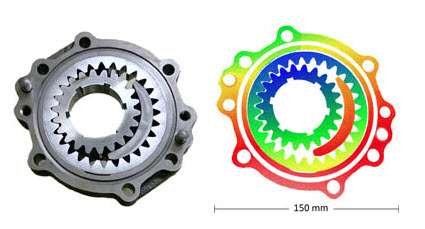Novel designs for interference microscopy objectives earn Rudolf Kingslake Medal

Two researchers from Zygo Corporation are recipients of the Rudolf Kingslake Medal and Prize for 2016. The award is presented annually to the most noteworthy original paper published in the journal Optical Engineering by SPIE, the international society for optics and photonics.
Peter de Groot and James Biegen are the authors of "Interference microscope objectives for wide-field areal surface topography measurements," published with open access in the July 2016 issue of the journal. The award will be presented at a banquet during SPIE Optics and Photonics in San Diego, California, in August.
From the fabrication of diesel fuel injectors to patterned semiconductor wafers, surface metrology on the microscopic scale is an essential step in the precision manufacturing and production of many modern products. To increase the field of view on current state-of-the-art microscopes for interferometry, multiple obstacles must be addressed, including the size, weight, and form factor of classical interference objectives.
The researchers propose a type of low-magnification interference objective that extends the range of application for flexible microscope platforms to larger fields of view. They write, "The objective comprises a beam splitter plate and a partially transparent reference mirror arranged coaxially with the objective lens system. The coaxial plates are slightly tilted to direct unwanted reflections outside of the imaging pupil aperture, providing high fringe contrast with spatially extended white-light illumination."
The study features two separate designs; a turret-mountable 1.4× magnification objective parfocal with high-magnification objectives up to 100×, and a dovetail mount 0.5× objective with a 34×34??mm field. These designs are a practical alternative to the classical Michelson and Mirau type objectives, which have been the standard objectives for most of the history of surface topography interference microscopy.
Peter de Groot is the executive director of R&D at Zygo Corporation. His research focuses on optical metrology for form, texture, part dimensions, and position. He has published over 140 technical papers, tutorials, and book chapters in the fields of physics, interferometry, stage motion measurement, and international metrology standards. His research has led to 130 U.S. patents for optical instruments. He is an SPIE Fellow and active contributor in the optics community.
James Biegen is a senior technical staff member at Zygo Corporation, specializing in the optical design of advanced metrology instrumentation. His interests range from laser Fizeau interferometry to interference microscopy, covering the complete product development cycle from applied research to manufacturing engineering. His contributions include physical optics modeling and the invention of high-precision interference objectives for both laser and white-light illumination. His work is highlighted in multiple U.S. patents and peer-reviewed journal articles.
Michael Eismann, Chief Scientist, Sensors Directorate, Air Force Research Laboratory, Wright-Patterson Air Force Base, is editor-in-chief of Optical Engineering. The journal is published in print and digitally by SPIE in the SPIE Digital Library, which contains more than 458,000 articles from SPIE journals, proceedings, and books, with approximately 18,000 new research papers added each year.
More information: Peter J. de Groot et al, Interference microscope objectives for wide-field areal surface topography measurements, Optical Engineering (2016). DOI: 10.1117/1.OE.55.7.074110
Provided by SPIE




















